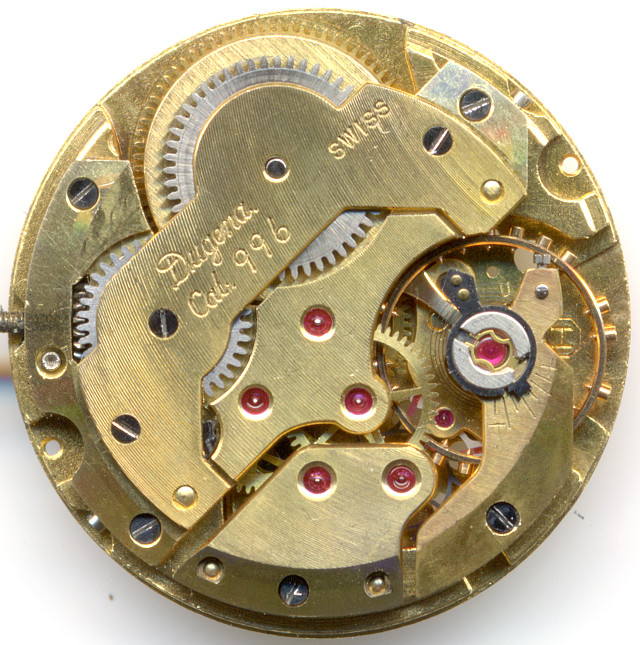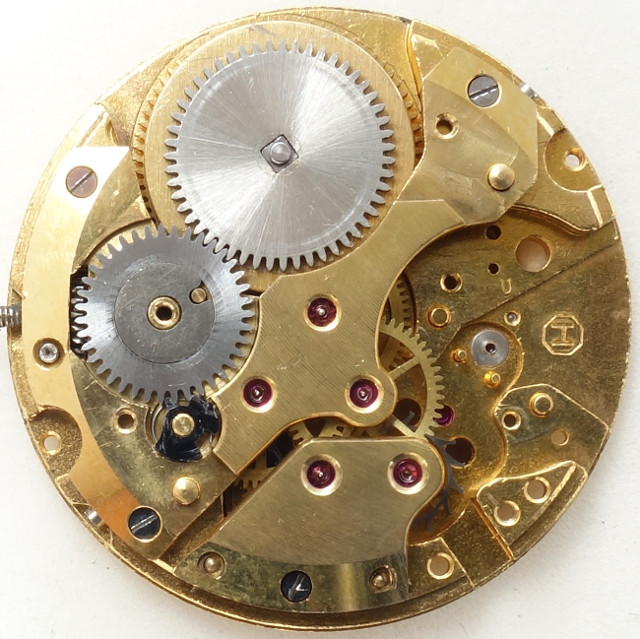Description
For its “Precision” line, Dugena used high quality swiss movements, among then the Helvetia 830 shown here, which Dugena marked as “Dugena 996”
The Helvetia 830 is a manual wind movement with a diameter of 11 1/2 lignes and an odd gear train. Because of its construction with bevelled edges, valuable millimeters of height could be saved.
It has got a golden toned Glucydur screw balance, so it is visually very appealing. The balance is shock protected and beats slowly with 18000 A/h. There’s no fine adjusting system, not even a long regulator arm. This does not really justify the “Precision” designation.
The golden toned base plate does not reveal much yet, except, that from the third wheel bearing on (at 7 o’clock, near the center), there are no ruby bearings any more. Since the movement comes up with 17 jewels, this is a first indication, that there have to be faster turning wheels with bearing rubies on other positions.
When the directly driven, non ruby beared center minute wheel is mounted below its cock, you see a further bearing on half height. It looks, that there’s another wheel in the gear train, but for what?
Now it becomes interesting!
The gear train consists of no less than six gears. It is probably one of the most complex gear trains for a movement whose only complication is a directly driven center second. Normally, this can achieved with four gears only.
The gear train is, from fast to slow:
Escapement wheel - seconds wheel (at 6 o’clock) - transmission wheel - center seconds wheel - third wheel - center minute wheel - mainspring barrel.
The transmission wheel is responsible, that the seconds wheel and the center seconds wheel are synchronized. The center seconds wheel also engages with the third wheel.
Mind blowing, or not? The only imaginable reason for such an odd construction is, that this movement could have been equipped either with a decentral second or with a central second indication, but it seems, that only the version with center seconds indication was produced.
Another interesting fact of this movement is, that the ratchet is open beared and only fixed with its flat top plate. Probably another few tenth of a millimeter could be saved with that construction. In the 1950ies, this was important, since flat watches were very popular then.
There are no surprises on the dial side. You can see the yoke winding system, the setting lever angel with four holes and the potential position of a decentral second hand at 6 o’clock.
The plate on the dial side is also flattened on its edge to save a little height. Additionally, the flat version of the Incabloc shock protection was used on the dial side.
Technical data
| Manufacturer: | Helvetia |
| Caliber: | 830 |
| Size: | 11 1/2''' (measured: 25,6mm) |
| A/h: | 18000 |
| Number of jewels: | 17 |
| Escapement: | Pallet lever |
| Balance types: | Glucydur screw balance |
| Shock protection(s): | Incabloc |
| Balance bearing / direction hairspring: | Counterclockwise |
| Moveable stud: | no |
| Adjust mechanism: | Hairspring key |
| Construction: |
|
| Construction type: | solid construction |
| Winding mechanism: | yoke winding system |
| Setting lever spring: | 4 hole(s) |
| Features: |
|
| References: | Flume: 1957 34 |
| Inventory number: | 18016 |







